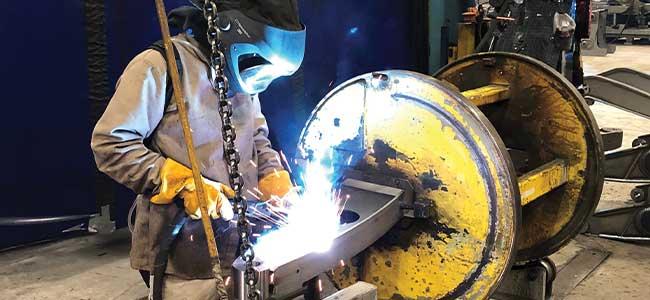
Breathing Easier: The Importance of an Effective Respiratory Protection Program
A solid respiratory protection program includes understanding the hazards, having the right types of respirators and filters or cartridges, and ensuring workers know how to use and maintain them properly.
- By Tom Burgess
- Aug 01, 2023
I’ve seen it often in several workplaces, and most people don’t know how dangerous and ineffective it can be.
People may hold onto respirators and cartridges for years, without knowing that those trusty chemical cartridges inside have a limited shelf life and must be replaced regularly. It’s a classic case of thinking you’re fully protected, but you’re not. And that’s not all. Picture this: you have a dirty work area, and what do you find hanging on the wall next to where employees hang their jackets? Respirators! Collecting whatever is in the air that they are intended to be providing protection from.
And that’s when the importance of having a solid respiratory protection program comes into play. It takes more than just issuing respirators to make sure they are providing the protection we want. That includes making sure we understand the hazards and have the right types of respirators and filters or cartridges, that workers know how to use them properly, and observing how they are used and maintained.
While respirator designs have seen limited changes, recent advances in managing respiratory protection programs and emerging trends have been driving improvements in this field. This includes online tools to help determine the type of respirator, including the OSHA Advisor Genius: Selecting an Appropriate Respirator and the NIOSH MultiVapor™ app to estimate how long a chemical cartridge will last.
Respirator Improvements
In the wake of the COVID-19 pandemic, the importance of respiratory protection reached unprecedented levels, particularly in healthcare. Extensive research efforts have focused on improving the comfort and efficacy of N95 respirators, which are crucial for safeguarding healthcare workers from airborne infections.
Materials science and ergonomic design advances have resulted in respirators that offer enhanced breathability and improved fit, minimizing discomfort during prolonged use. Moreover, the increased emphasis on respiratory protection in healthcare has paved the way for cross-industry learning, where strategies employed in medical settings are adapted to other occupational exposures.
Certain industries and occupations demand stringent respiratory protection measures due to the nature of their work. Emergency responders, firefighters, and individuals working with highly hazardous materials face unique challenges that necessitate high levels of respiratory protection. The physically demanding nature of these occupations, combined with exposure to hazardous substances, increases the risk of adverse health effects. Consequently, respiratory protection and industrial hygiene programs must specifically address and mitigate these risks.
Inadequate respiratory protection exposes workers to various health risks, including inhaling harmful chemicals and mechanical damage caused by particulate matter. Additionally, substances like crystalline silica, when inhaled, can penetrate deep into the lungs, and cause mechanical damage.
With their delicate tissues, the lungs are particularly vulnerable to airborne toxins, as gases and particulates can easily penetrate and enter the bloodstream. These health risks emphasize the critical need for effective respiratory protection measures in the workplace. Instances of workers using incorrect or improperly maintained respirators are not uncommon.
In addition to training on respirators’ proper use, maintenance, limitations, and storage, it is important to follow up and provide coaching when needed. Employees should be able to inspect, put on, adjust, and remove respirators correctly, as well as identify the signs of a compromised seal or malfunctioning equipment.
During my site visits, I always find it important to observe the work, exposures, respirator use and get input from the workers. What is the nature of the exposures? Do workers understand the types of exposures and risks? Do they have any problems or non-routine tasks that may need more evaluation? This is a part of managing an effective respiratory protection program, and why it is important to assign a program administrator that takes an active role in assessing the program.
Medical Evaluation
One OSHA-required element of the respiratory protection program where I see wide variation in practice is the medical evaluation. When OSHA issued the first respiratory protection standard in 1972, it was recognized that there could be medical concerns with respirator use. While the standard had a major revision in 1998, the medical evaluation requirements have remained unchanged for 50 years, even though the understanding of respirators and health concerns has significantly advanced.
While OSHA has not made a change, the medical practice supporting respirator use has changed. New options that make it easy to manage medical evaluations are available such as online questionnaires reviewed by a medical professional.
Improvements in respirator design over the years include different materials, improvements in worker comfort, and communication, including wireless communication systems for use with respirators. Other technological improvements include lighter and longer-lasting powered air-purifying respirators (PAPRs). Advancements in wearable sensor technologies have facilitated real-time monitoring of worker exposures to verify that respiratory protection is suitable for the level exposure and warn the user and safety before acceptable levels such as the Immediately Dangerous to Life or Health (IDLH) limit for a negative pressure respirator are exceeded.
Effective respiratory protection requires addressing a variety of issues, from understanding exposures to making sure respirators are properly stored and maintained. Technology and particularly online resources have made it easy to manage a respiratory protection program, but never forget the importance of seeing where and how they are being used and getting input from the users.
This article originally appeared in the August 1, 2023 issue of Occupational Health & Safety.